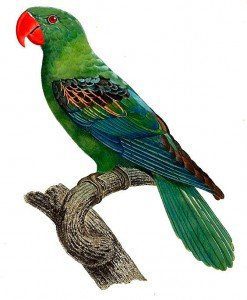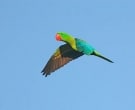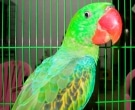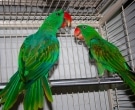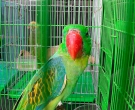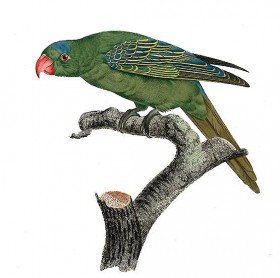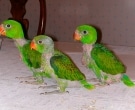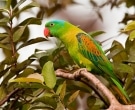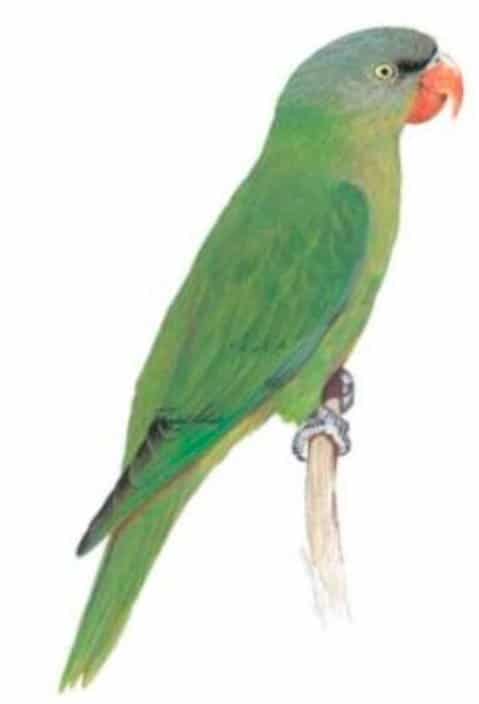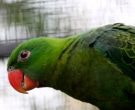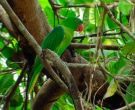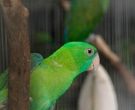Content
|
|---|
Description
33 to 43 cm.. length and an approximate weight of 260 g..
The Great-billed Parrot (Tanygnathus megalorynchos) It has a bright green head. Green mantle with narrow blue stripes to the feathers of the back; pale blue rump; coverts underwings light green.
Scapulars black bordered of blue-green; less black on the inner wing coverts, the blue-green external; medium black coverts, with yellow margins in both bands: large blue-green coverts with yellow margins.
Secondary green with thin yellow margins; primary heavily drenched blue in vane external with a gradient through the greenish or blackish blue in the vane inner. The wings and bright yellow axillary feathers; lower part of flight feathers black gray, the inner most dyed yellow.
The underparts, greenish yellow, greener-tinged in the belly, the coverts and thighs undertail. Upper, green tail with yellow tips; at the bottom I light brown with orange tips.
Billed red; iris yellow ; black legs.
Males and the females similar.
Young with beaming less variegated in wings.
- Sound of the Great-billed Parrot.
Subspecies
Habitat:
The Great-billed Parrot is distributed mainly primary lowland forests, as well as in secondary and coastal forests, mangroves, cultivated areas, gardens and plantations up to 1.000 meters above sea level. The birds regularly travel between the smaller islands and make daily flights between roosts and areas of foraging, calling the attention with its loud cries in flight as a time to settle to rest.
They normally gather in small groups of up to a dozen individuals in search of food., usually fruits and nuts, and commonly throw the remains of from the trees where they feed, since they discard unwanted elements.
Reproduction:
Nesting has been recorded between August and December, Noting a nest in the hollow of a mature tree in the forest at a height of some 30 m.
Food:
The fruit of the Sonneratia alba, as well Canarium vulgare and casuarinas.
Distribution:
Widely but unevenly distributed across Nusa Tenggara, the Moluccas and Islands to the West of papua. The range includes the following Islands: Sumba, Timor (West end) and adjacent Semau , Flowers, Madu, Kalaotowa, Kalao, Tanahjampea, the Group Tukangbesi to the southwest of Sulawesi, Damar, Babar, the Group Tanimbar, Seram, Haruku, Buru, OBI, Bacan, Kayoa, Halmahera, Makian, Moti, Ternate, Ternate, Morotai, Mayu, islets to the North of Sulawesi and the Group Togian to the East of Sulawesi, Sangir and groups Talaud, Widi, Muor, give, Waigeo, Batanta, Salawati and Misool. The nominal race seems to have been introduced in Balut at the southern end of Mindanao, Philippines. Occasional records in Java and Bali they are probably leaks, but the birds on the Mainland of New Guinea they may be wandering genuine, probably from the small islands of the West Group of papua. The species is quite common, but you might be getting some local decreases as a result of trade and habitat loss. The world population is estimated at more of 100.000 birds.
Subspecies
Conservation:
• Current category of the Red List of the UICN: Least concern
• Population trend: Decreasing
The world population is estimated at more of 100.000 birds.
This species has a very large range, and therefore not approaching the thresholds for Vulnerable according to the range size criterion.
The population is suspected to be declining due to the destruction of habitat in course and unsustainable levels of exploitation.
"Great-billed Parrot" in captivity:
Quiet, little shrill, don't like to be touched.
Rare in captivity.
Alternative names:
– Great-billed Parrot, Great billed Parrot, Island Parrot, Large-billed Parrot, Moluccan Parrot (ingles).
– Perruche à bec de sang, Perruche à gros bec (French).
– Schwarzschulterpapagei, Schwarzschulter-Papagei (German).
– Tanygnathus megalorynchos (Portuguese).
– Loro de Pico Grueso, Loro Picogordo, Loro Picogoro (español).
scientific classification:
– Order: Psittaciformes
– Family: Psittaculidae
– Genus: Tanygnathus
– Scientific name: Tanygnathus megalorynchos
– Citation: (Boddaert, 1783)
– Protonimo: Psittacus megalorynchos
Images “Great-billed Parrot”
Videos "Great-billed Parrot"
————————————————————————————————
“Great-billed Parrot” (Tanygnathus megalorynchos)
Sources:
– Avibase
– Parrots of the World – Forshaw Joseph M
– Parrots A Guide to the Parrots of the World – Tony Juniper & Mike Parr
– Loromania
– Birdlife
– Photos:
(1) – By TJ Lin (originally posted to Flickr as photo 1445) [CC BY-SA 2.0 (http://creativecommons.org/licenses/by-sa/2.0)], via Wikimedia Commons from Wikimedia Commons – Wikimedia
(2) – By TJ Lin (originally posted to Flickr as great-billed parrot) [CC BY-SA 2.0], via Wikimedia Commons
(3) – “Tanygnathus megalorynchos-two in captivity-8a” by TJ Lin – originally posted to Flickr as photo 1466. Licensed under CC BY-SA 2.0 via Wikimedia Commons.
(4) – «Tanygnathus megalorynchos-captivity-8a" for TJ Lin – originally posted to Flickr as great-billed parrot. Disponible bajo la licencia CC BY-SA 2.0 via Wikimedia Commons.
(5) – A bird in flight by James Eaton – Lynx
(6) – “Tanygnathus megalorynchos – Barraband“. Licensed under Public Domain via Wikimedia Commons.
– Sounds: Mike Catsis (Xeno-canto)

